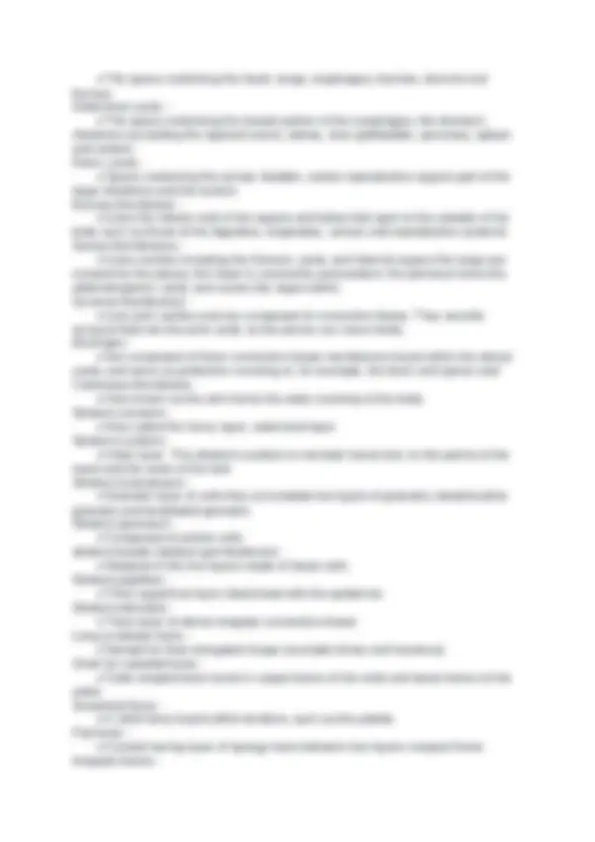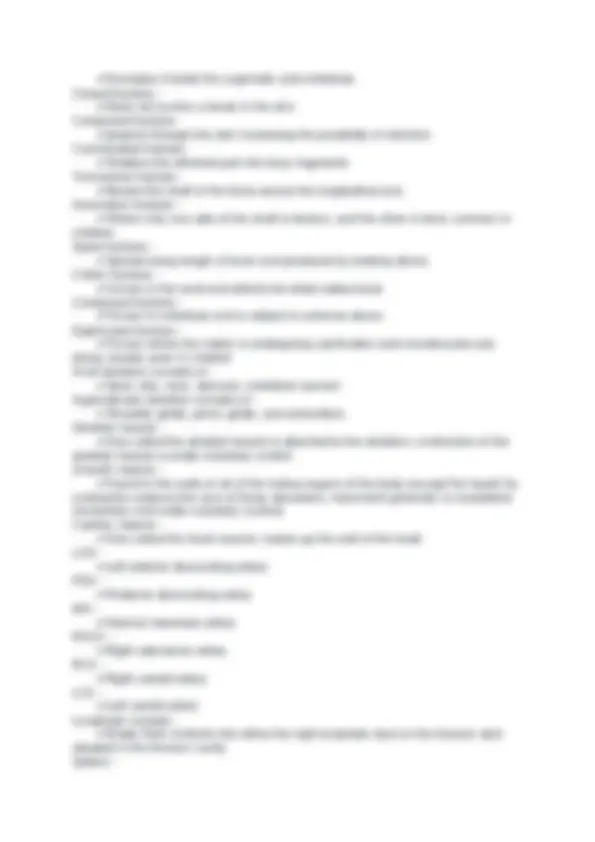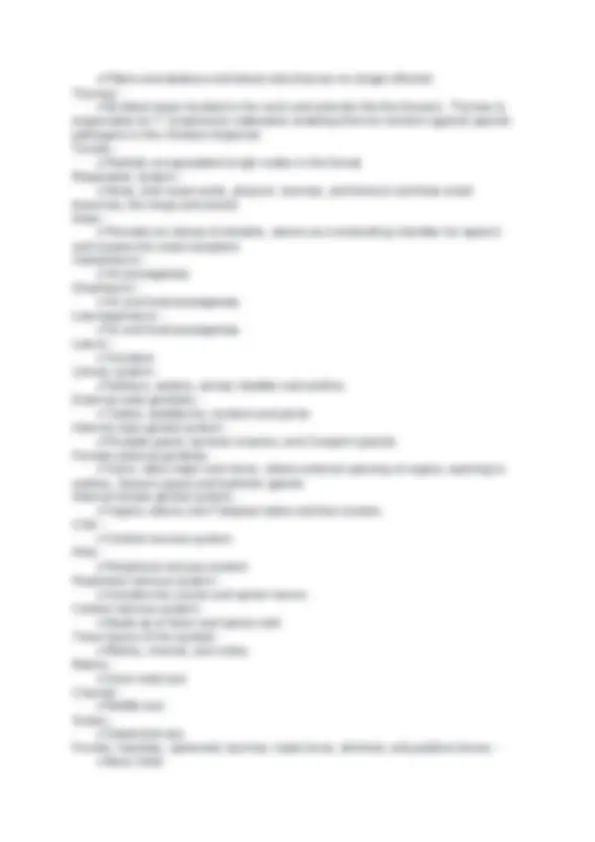





Study with the several resources on Docsity

Earn points by helping other students or get them with a premium plan


Prepare for your exams
Study with the several resources on Docsity

Earn points to download
Earn points by helping other students or get them with a premium plan
Community
Ask the community for help and clear up your study doubts
Discover the best universities in your country according to Docsity users
Free resources
Download our free guides on studying techniques, anxiety management strategies, and thesis advice from Docsity tutors
AAPC CPC Study Guide Chapter 2 Med Term and Anatomy
Typology: Exams
1 / 6

This page cannot be seen from the preview
Don't miss anything!




Blephar/o - ✔Eyelid Bucc/o - ✔Cheek Cholecyst/o - ✔Gallbladder Colp/o - ✔Vagina Cyst/o - ✔A fluid sac or pouch, urinary bladder Derm/o - ✔Skin Encephal/o - ✔Brain Enter/o - ✔Intestines Hem/o, Hemat/o - ✔Blood My/o - ✔Muscle Myel/o - ✔Spinal cord, bone marrow Onych/o - ✔Nail Oste/o - ✔Bone Phleb/o - ✔Vein Pulm/o - ✔Lungs Synov/i - ✔Synovial fluid, joint, or membrane Ab- - ✔Away from Ad- - ✔Toward, near Ante- - ✔Before Ec-, Ecto- - ✔In, within Mon/o - ✔One Poly- - ✔Many, much Post- -
✔After, behind -centesis - ✔Puncture -desis - ✔Binding, fusion -ectomy - ✔Excision, surgical removal -graphy - ✔Act of recording data -pexy - ✔Surgical fixation -plasty - ✔Plastic repair, plastic surgery, reconstruction -tripsy - ✔Crushing Anterior (ventral) - ✔Toward the front of the body Posterior (dorsal) - ✔Toward the back of the body Medial - ✔Toward the midline of the body Lateral - ✔Toward the side of the body Proximal - ✔Nearer to the point of attachment or to a given reference point Distal - ✔Farther point of attachment or from a given reference point Superior (cranial) - ✔Above; toward the head Inferior (caudal) - ✔Below; toward the lower end of the spine Superficial (external) - ✔Closer to the surface of the body Deep ( internal) - ✔Closer to the center of the body Sagittal - ✔Cut through the midline of the body from front to back dividing the body into right and left sections Frontal (coronal) - ✔Cuts at a right angle to the midline, from side to side dividing the body into front (anterior) and back (posterior) sections. Transverse ( horizontal) - ✔Cuts horizontally through the body separating the body into upper (superior) and lower (inferior) sections Organs of cranial cavity - ✔The space inside this skull or cranium containing the brain Spinal (vertebral) cavity - ✔Space inside the spinal column containing the spinal cord Thoracic, or chest cavity -
✔Examples include the zygomatic and vertebrae Closed fracture - ✔Does not involve a break in the skin Compound fracture - ✔projects through the skin increasing the possibility of infection Comminuted fracture - ✔Shatters the affected part into bony fragments Transverse fracture - ✔Breaks the shaft of the bone across the longitudinal axis Greenstick fracture - ✔Where only one side of the shaft is broken, and the other is bent; common in children Spiral fracture - ✔Spread along length of bone and produced by twisting stress Colles' fracture - ✔Occurs in the wrist and affects the distal radius bone Compound fracture - ✔Occurs in vertebrae and is subject to extreme stress Epiphyseal fracture - ✔Occurs where the matrix is undergoing calcification and chondrocytes are dying; usually seen in children Axial skeleton consists of - ✔Skull, ribs, neck, sternum, vertebrae sacrum Appendicular skeleton consists of - ✔Shoulder girdle, pelvic girdle, and extremities Skeletal muscle - ✔Also called the striated muscle is attached to the skeleton; contraction of the skeletal muscle is under voluntary control Smooth muscle - ✔Found in the walls of all of the hollow organs of the body (except the heart) Its contraction reduces the size of these structures; movement generally is considered involuntary (not under voluntary control) Cardiac muscle - ✔Also called the heart muscle; makes up the wall of the heart LAD - ✔Left anterior descending artery PDA - ✔Posterior descending artery IMA - ✔Internal mammary artery RSCA - ✔Right subclavian artery RCA - ✔Right carotid artery LCA - ✔Left carotid artery Lymphatic vessels - ✔Empty their contents into either the right lymphatic duct or the thoracic duct situated in the thoracic cavity Spleen -
✔Filters and destroys red blood cells that are no longer efficient Thymus - ✔Bi-lobed organ located in the neck and extends into the thoracic. Thymus is responsible for T- lymphocyte maturation enabling them to function against specific pathogens in the immune response Tonsils - ✔Partially encapsulated lymph nodes in the throat Respiratory system - ✔Nose, and nasal cavity, pharynx, trachea, and bronchi and their small branches, the lungs and alveoli Nose - ✔Provides an airway to breathe, serves as a resonating chamber for speech and houses the smell receptors nasopharynx - ✔Air passageway Oropharynx - ✔Air and food passageway Laryngopharynx - ✔Air and food passageway Larynx - ✔Voicebox Urinary system - ✔Kidneys, ureters, urinary bladder and urethra External male genitalia - ✔Testes, epididymis, scrotum and penis Internal male genital system - ✔Prostate gland, seminal vesicles, and Cowper's glands. Female external genitalia - ✔Vulva. labia major and minor, clitoris external opening of vagina, opening to urethra, Skene's gland and bartholin glands Internal female genital system - ✔Vagina, uterus, two Fallopian tubes and two ovaries CNS - ✔Central nervous system PNS - ✔Peripheral nervous system Peripheral nervous system - ✔Includes the cranial and spinal nerves Central nervous system - ✔Made up of brain and spinal cord Three layers of the eyeball - ✔Retina, choroid, and sclera Retina - ✔Inner-most eye Choroid - ✔Middle eye Sclera - ✔Outermost eye Frontal, maxillary, sphenoid, lacrimal, malar bone, ethmoid, and palatine bones - ✔Bony Orbit